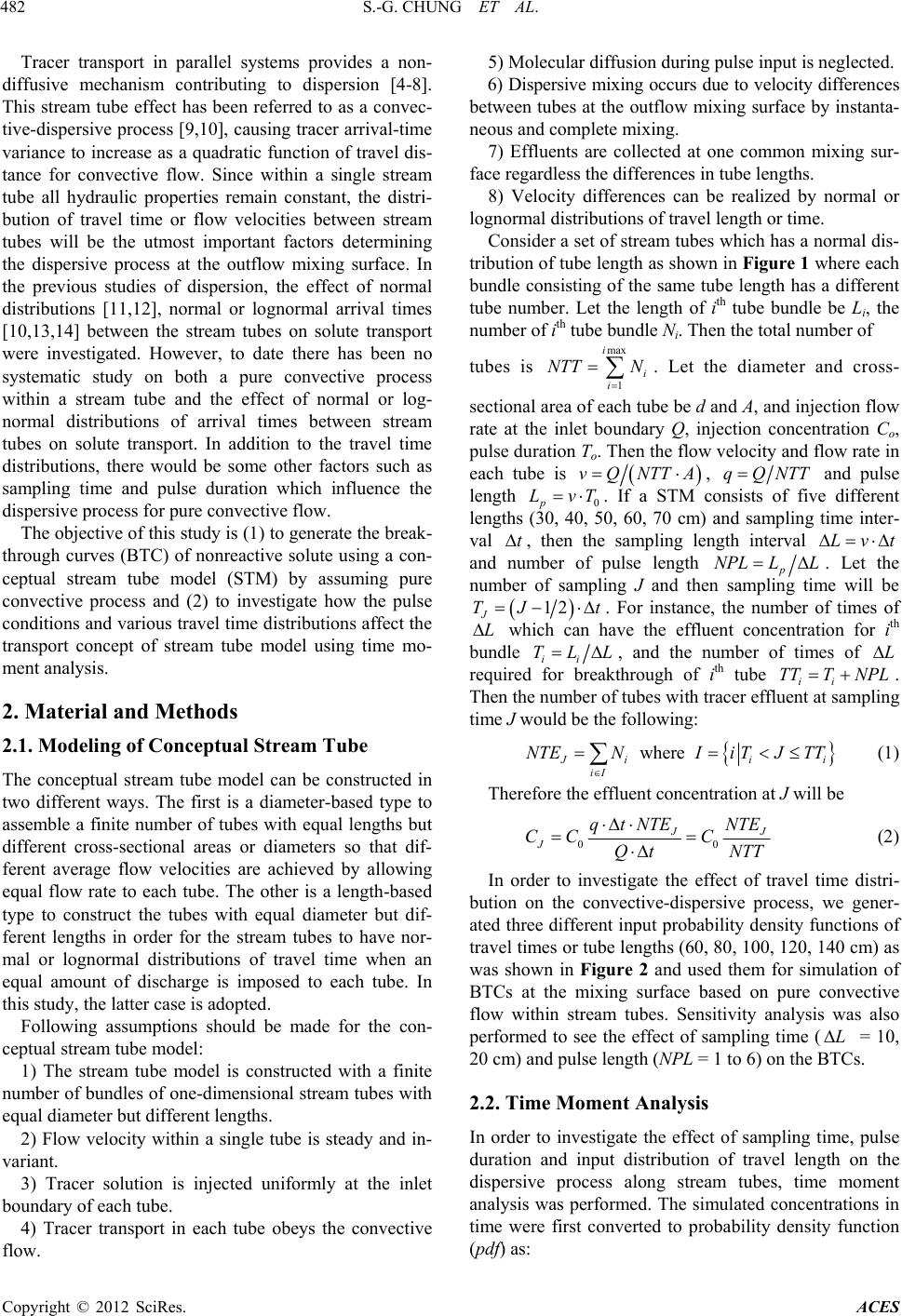
S.-G. CHUNG ET AL.
482
Tracer transport in parallel systems provides a non-
diffusive mechanism contributing to dispersion [4-8].
This stream tube effect has been referred to as a convec-
tive-dispersive process [9,10], causing tracer arrival-time
variance to increase as a quadratic function of travel dis-
tance for convective flow. Since within a single stream
tube all hydraulic properties remain constant, the distri-
bution of travel time or flow velocities between stream
tubes will be the utmost important factors determining
the dispersive process at the outflow mixing surface. In
the previous studies of dispersion, the effect of normal
distributions [11,12], normal or lognormal arrival times
[10,13,14] between the stream tubes on solute transport
were investigated. However, to date there has been no
systematic study on both a pure convective process
within a stream tube and the effect of normal or log-
normal distributions of arrival times between stream
tubes on solute transport. In addition to the travel time
distributions, there would be some other factors such as
sampling time and pulse duration which influence the
dispersive process for pure convective flow.
The objective of this study is (1) to generate the break-
through curves (BTC) of nonreactive solute using a con-
ceptual stream tube model (STM) by assuming pure
convective process and (2) to investigate how the pulse
conditions and various travel time distributions affect the
transport concept of stream tube model using time mo-
ment analysis.
2. Material and Methods
2.1. Modeling of Conceptual Stream Tube
The conceptual stream tube model can be constructed in
two different ways. The first is a diameter-based type to
assemble a finite number of tubes with equal lengths but
different cross-sectional areas or diameters so that dif-
ferent average flow velocities are achieved by allowing
equal flow rate to each tube. The other is a length-based
type to construct the tubes with equal diameter but dif-
ferent lengths in order for the stream tubes to have nor-
mal or lognormal distributions of travel time when an
equal amount of discharge is imposed to each tube. In
this study, the latter case is adopted.
Following assumptions should be made for the con-
ceptual stream tube model:
1) The stream tube model is constructed with a finite
number of bundles of one-dimensional stream tubes with
equal diameter but different lengths.
2) Flow velocity within a single tube is steady and in-
variant.
3) Tracer solution is injected uniformly at the inlet
boundary of each tube.
4) Tracer transport in each tube obeys the convective
flow.
5) Molecular diffusion during pulse input is neglected.
6) Dispersive mixing occurs due to velocity differences
between tubes at the outflow mixing surface by instanta-
neous and complete mixing.
7) Effluents are collected at one common mixing sur-
face regardless the differences in tube lengths.
8) Velocity differences can be realized by normal or
lognormal distributions of travel length or time.
Consider a set of stream tubes which has a normal dis-
tribution of tube length as shown in Figure 1 where each
bundle consisting of the same tube length has a different
tube number. Let the length of ith tube bundle be Li, the
number of ith tube bundle Ni. Then the total number of
max
1
i
i
i
NTT N
. Let the diameter and cross- tubes is
sectional area of each tube be d and A, and injection flow
rate at the inlet boundary Q, injection concentration Co,
pulse duration To. Then the flow velocity and flow rate in
each tube is
vQNTTA
,
qQNTT
LvT and pulse
length 0p
t
. If a STM consists of five different
lengths (30, 40, 50, 60, 70 cm) and sampling time inter-
val Lvt
, then the sampling length interval
and number of pulse length p. Let the
number of sampling J and then sampling time will be
NPL LL
12
J
TJ t
L. For instance, the number of times of
which can have the effluent concentration for ith
bundle ii
TLLL, and the number of times of
required for breakthrough of ith tube ii
TT .
Then the number of tubes with tracer effluent at sampling
time J would be the following:
T NPL
where
iii
iI
NTENIi TJTT
(1)
Therefore the effluent concentration at J will be
00
J
J
qtNTE NTE
CC C
Qt NTT
L
(2)
In order to investigate the effect of travel time distri-
bution on the convective-dispersive process, we gener-
ated three different input probability density functions of
travel times or tube lengths (60, 80, 100, 120, 140 cm) as
was shown in Figure 2 and used them for simulation of
BTCs at the mixing surface based on pure convective
flow within stream tubes. Sensitivity analysis was also
performed to see the effect of sampling time (
= 10,
20 cm) and pulse length (NPL = 1 to 6) on the BTCs.
2.2. Time Moment Analysis
In order to investigate the effect of sampling time, pulse
duration and input distribution of travel length on the
dispersive process along stream tubes, time moment
analysis was performed. The simulated concentrations in
time were first converted to probability density function
(pdf) as:
Copyright © 2012 SciRes. ACES